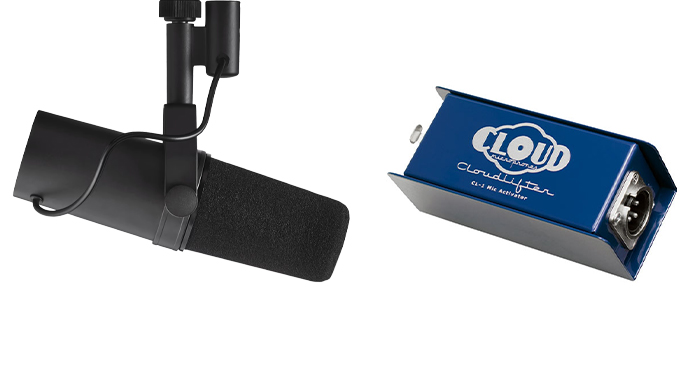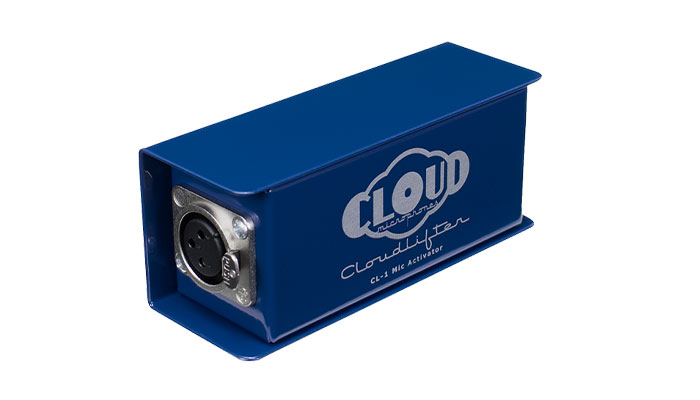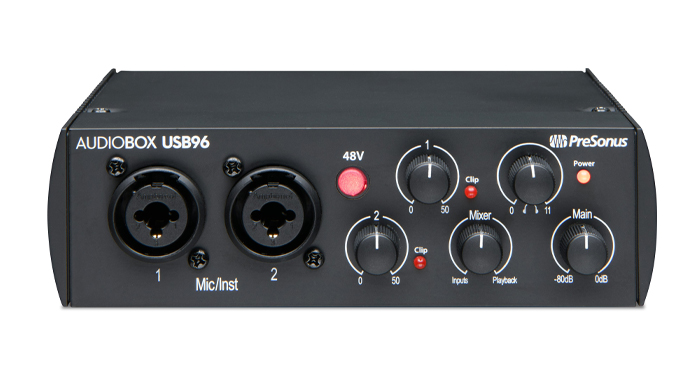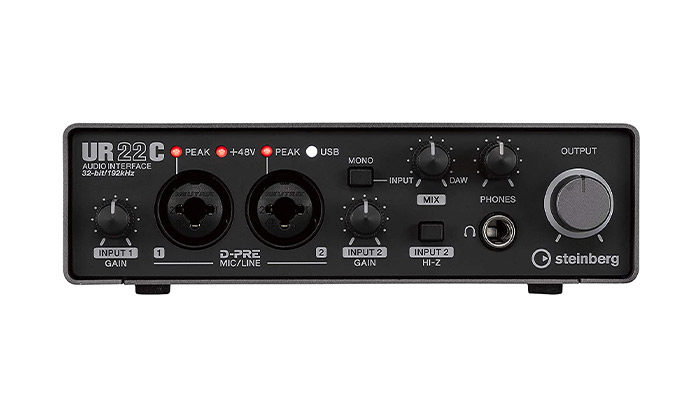
Let me guess. You just bought your Shure SM7B dynamic microphone because you want to get the best audio quality for your music or recordings. You connect it to your interface, and although everything seems great at first, you realize something’s not quite like you expected it to be.
There’s a huge difference in quality between the podcasts you love and the audio you just recorded. You think something is wrong with your microphone, or perhaps your interface is faulty.
When you search online, you come across incomprehensive words like “Cloudlifter” and “phantom power”, and wonder what to do next to get the sound you envisioned.
Let’s start by saying the legendary Shure SM7B is one of the most popular dynamic microphones to record vocals, as well as other instruments: it’s a must-have for podcasters, streamers, and musicians alike looking for pristine audio quality.
In this article, I’ll explain how to make the most of this extraordinary microphone, thanks to one of the best microphone boosters: the CL-1 Cloudlifter. Let’s dive in!

The Cloudlifter CL-1 Cloud Microphones is an inline preamp that provides +25dB of clean gain to your dynamic microphone before the sound reaches your mic preamp. It was built with the cloud ribbon microphone in mind, but it will help any low-sensitive, and ribbon mics to get their best possible sound.
The Cloudlifter is not a mic level to line level preamp. You’ll still need an interface or a mixer with your inline preamp; however, and especially when combined with a Shure SM7B dynamic mic, the +25dB boost from the CL-1 will allow you to preserve the natural sound of the microphone and a good output level.
To use the Cloudlifter, connect your Shure SM7B to the input line of the CL-1 with an XLR cable. Then connect the output from the CL-1 to your interface with an additional XLR cable.
It’s worth mentioning that the CL-1 requires phantom power to work, which most audio interfaces have nowadays. But fear not, the CL-1 won’t apply phantom power to ribbon microphones.
If you’re still asking yourself: “what does a Cloudlifter do?” make sure you check out our recent in-depth article on the topic.
Let’s analyze one by one the various reasons why you need a Cloudlifter for your Shure SM7B dynamic microphone.
When buying audio equipment, you need to know the crucial specs of your microphone and interface.
The Shure SM7B is a low-sensitive microphone, and like all low output mics, it requires a mic preamp with at least 60dB of clean gain, meaning our interface should provide that gain.
Many audio interfaces are built for condenser microphones, which are high-sensitive microphones and don’t require much gain. Because of this, most low-end audio interfaces don’t supply enough gain volume.
What you need to look at in your interface is its gain range. If a gain range is less than 60dB, it will not provide enough gain for your SM7B, and you will require an inline preamp, like the Cloudlifter, to get a higher volume from it.
Let’s take some of the most common interfaces as examples.

The Focusrite Scarlett has a gain range of 56dB. With this interface, you’d need to turn your gain knob to the max to have a decent (not optimal) microphone signal.

The AudioBox USB 96 has a 52dB gain range, so you won’t have enough gain power to supply your microphone.

The UR22C provides 60dB of gain range, the minimum for the SM7B.
In the three examples above, you can use your SM7B. But only with the Steinberg can you get the best audio quality from your mic.
The second reason you could need a Cloudlifter is to improve the signal-to-noise ratio. Some audio interfaces, specifically cheap interfaces, have too much self-noise, which gets amplified when turning the knob to the maximum volume.
Let’s take as an example the Focusrite Scarlett 2i2, which is one of the most common audio interfaces these days. I mentioned how you would need to turn the gain knob all the way to the max to get some decent levels; however, doing this could bring the noise floor up.
To reduce this noise, we can use an inline preamp: it will boost the levels of our mic before reaching the preamps on our audio interface, so we don’t have to overuse the gain. With less gain from the interface, less noise from the preamps will be amplified, and thus you’ll get a better sound quality from our mix.
Sometimes due to the conditions of our setup, especially in big studios and auditoriums, we need to run long cables from our microphones to the console or audio interfaces. With long cable runs, the levels can lose gain significantly. The Cloudlifter, or any inline preamp, can help us reduce that drain as if the sound source was closer.
You don’t necessarily need a Cloudlifter for your SM7B to reduce noise. If reducing other sounds is all you want, then an inline preamp might not be that necessary.
The problem with preamps self-noise is that pushing their limits results in hissed sounds entering your mix, which you could edit in our DAW using a noise gate and other plugins in post-production.
If you want to avoid post-editing, you should keep an eye on EIN (Equivalent Input Noise). EIN means how much noise generates the preamps: a preamp with EIN -130 dBu will provide zero-level noise. Most preamps in modern audio interfaces are around the -128 dBu, which is considered low noise.
The better your interface, the better the preamps it comes with: if the quality of your interface is high, you won’t need a Cloudlifter, at least for noise reduction. But what happens if I have a cheap interface? Or one with very high EIN (a -110dBu would be higher than a -128dBu). In that case, having an inline preamp in our rig can reduce picking up other sounds considerably.
Because the SM7B is a low-sensitive mic that requires plenty of gain, if your preamps are noisy, pushing their gain will also amplify other sounds. That’s why the Cloudlifter will significantly help with the Shure SM7B.
Consider the inline preamp a cheaper way to reduce the noise from old or noisy interfaces. But keep in mind noise can come from many sources. The Cloudlifter will only reduce noise from your preamp.
When the source is close to the mic, the levels will increase, but the signal could get distorted, plosives will be more noticeable, and you will lose audio quality.
In short, the Cloudlifter is unnecessary if your only concern is reducing noise. A better-quality preamp (EIN at -128dBu) will help you with unwanted sounds, and using any inline preamp won’t make much difference.
Of course, that means extra cost. If your current preamps are noisy, maybe investing in a Cloudlifter CL-1 would be a better choice for you than a brand new interface.
On the other hand, if your problem is getting the proper levels, then you should use an inline preamp: you’ll hear the difference clearly, and you won’t need to raise the signal while recording.
There are many Cloudlifter alternatives. Look up to the DM1 Dynamite or the Triton FetHead, which are smaller and can be attached directly to the SM7B. These are the perfect size to hide behind the mic stand for a minimalist setup.
To understand more about these two, we compared Fethed vs Cloudlifter in our recent blog post.
The Shure SM7B dynamic microphone and a Cloudlifter CL-1 is a trustworthy bundles for any project involving music and human voice recordings for podcasters, streamers, and voice actors. Cloudfilter makes your recording studio more professional and the post-production process much more intuitive.
I hope this article has helped you understand when a Cloudlifter is needed and if you need one. Make sure you check the EIN and gain range on your interface to help you decide which equipment works best for you.
Yes. The Cloudlifter CL-1 is a mic activator and inline preamp that will work with your ribbon mics, turning even the cheapest preamp into a studio-quality ribbon preamp.
A condenser microphone won’t work with a Cloudlifter, as they are high-output microphones. The Cloudlifter will use the phantom power from your audio interface, but it won’t transfer to your condenser mic, which they require in order to function properly.
Shure SM7B does not require phantom power unless used in combination with an inline preamp like CloudLifter. While using the Shure SM7B on its own, a 48v phantom power won’t affect the quality or loudness of your audio recordings in any way. However, most external preamps compatible with the SM7B do require phantom power.